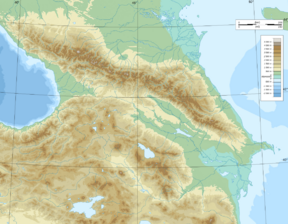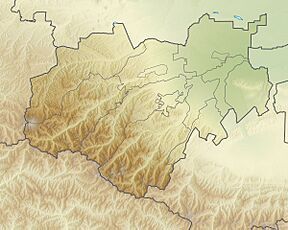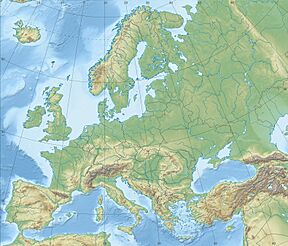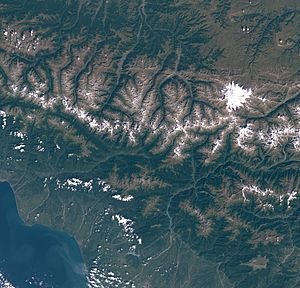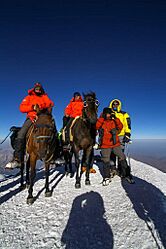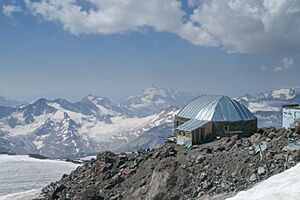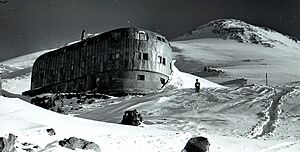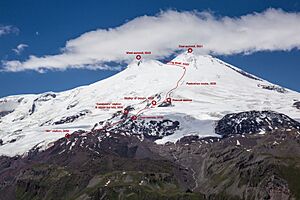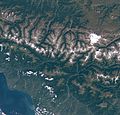Mount Elbrus facts for kids
Quick facts for kids Mount Elbrus |
|
|---|---|
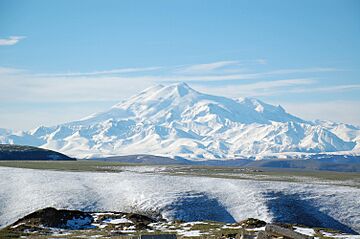
Mount Elbrus, seen from the north
|
|
| Highest point | |
| Elevation | 5,642 m (18,510 ft) |
| Prominence | 4,741 m (15,554 ft) Ranked 10th |
| Listing | Seven Summits Volcanic Seven Summits Country high point Ultra |
| Geography | |
| Country | Russia |
| Parent range | Lateral Range Caucasus Mountains |
| Topo map | Elbrus and Upper Baksan Valley by EWP |
| Geology | |
| Age of rock | Unknown |
| Last eruption | 50 AD ± 50 years |
| Climbing | |
| First ascent | (West summit) 1874, by Florence Crauford Grove, Frederick Gardner, Horace Walker and the guides Peter Knubel and 22 July 1829 by Killar Khashirov |
| Easiest route | Basic snow/ice climb |
Mount Elbrus is the highest mountain in both Russia and Europe. It is a dormant volcano, meaning it's not active right now but could be in the future. It stands tall at 5,642 m (18,510 ft) above sea level. Elbrus is also the highest stratovolcano in all of Eurasia, which is the huge landmass of Europe and Asia. It's located in the southern part of Russia, in the Caucasus Mountains.
Mount Elbrus has two main tops, called summits. Both are old volcanic domes that are now dormant. The western summit is the taller one at 5,642 metres (18,510 ft). The eastern summit is slightly lower at 5,621 metres (18,442 ft). The eastern summit was first climbed in 1829 by Khillar Khashirov. The western summit was first climbed in 1874 by a British team led by F. Crauford Grove.
Contents
What's in a Name?
The name Elbrus might be connected to Alborz, a mountain range in Iran. Both names come from an ancient word, Harā Bərəzaitī. This was a legendary mountain in old Iranian stories.
The word Bərəzaitī means "high" or "peak." You can see this in modern languages like Ossetian and Persian. The word Harā might mean "watch" or "guard." So, the name could mean something like "Guard Mountain" or "High Watch."
Local people have their own names for Elbrus. The Circassians call it "Uash-ha Makhua," which means "The mountain of happiness." The Karachays and Balkars call it "Mingi Taw," meaning "Eternal Mountain."
Where is Mount Elbrus?
Location and Surroundings
Mount Elbrus is in the northwest of the Caucasus Mountains. It's about 100 kilometers from the Black Sea. On very clear days, you might even see the Caspian Sea from its top. The mountain rises 5,642 metres (18,510 ft) above sea level.
Elbrus is on the border of two Russian areas: Kabardino-Balkaria and Karachay-Cherkessia. It's the highest point in both Russia and Europe. The mountain is about 65 kilometers southwest of Kislovodsk city. You can reach it by road from a major highway.
Part of the mountain is in Prielbrusye National Park. This park helps protect the natural beauty of the area. If you go south of the town of Baksan, you need special permits because it's close to the border.
Shape and Features
Elbrus looks like a nearly perfect cone, which is typical for a stratovolcano. It has two main peaks with a lower area between them. The western peak is the highest at 5,642 metres (18,510 ft), and the eastern peak is 5,621 metres (18,442 ft).
The top of the eastern peak used to have a large crater, about 300 to 400 meters wide. But over time, snow and ice have filled it up.
The mountain is covered by huge snowfields, covering an area of 138 km2. These snowfields feed 22 or 23 main glaciers and many smaller ones. These glaciers are the source of important rivers like the Baksan, Kuban, and Malka. Some glaciers are very thick, up to 400 meters! However, all of them are shrinking.
How the Mountain Was Formed
The Caucasus Mountains, including Elbrus, were formed when the Arabian Plate slowly crashed into the Eurasian Plate. This collision causes many earthquakes in the region.
Mount Elbrus started forming about 10 million years ago. It's a volcano, and the rocks and ash it shot out cover a huge area of 260 square kilometers. Scientists have studied these rocks to learn about its past eruptions. The main part of the volcano formed around 700,000 years ago.
Even today, you can sometimes see small fumaroles (gas vents) on the eastern side of Elbrus. There are also hot springs on the mountain's slopes. These are signs that there's still some heat deep inside the volcano.
When Did Elbrus Last Erupt?
Mount Elbrus is considered a dormant volcano. This means it's not erupting now, but it could become active again. The last time it erupted was around 50 AD.
You can still see signs of its past activity. There are several lava flows on the mountain that look quite fresh. The longest one stretches for 24 kilometres (15 mi) down the northeast side, showing it was a big eruption.
Weather on Elbrus
Mountain Climate
Because Elbrus is in the Northern Hemisphere, summer is from June to mid-September. During this time, about half the days are sunny, which is good for climbing. However, the weather can change very quickly. Strong winds are common, and temperatures can drop fast.
Above 4,000 meters, even in summer, blizzards can happen. This means heavy snow and almost no visibility. Winds can blow faster than 100 kilometers per hour. In winter, the temperature at the top can fall below -50°C. More snow falls as you go higher up the mountain.
The very top of Elbrus has an ice cap climate, meaning it's always covered in ice and snow. Snow falls about 45 days a year on average. Winters are generally drier than other seasons.
History of Elbrus
Ancient Stories
In ancient Greek stories, the Titan Prometheus was chained to a mountain in the Caucasus. This was his punishment for stealing fire from the gods and giving it to humans. Some writers believe this mountain, called Strobilos, was actually Mount Elbrus. The Greek word strobilos means something twisted or shaped like a pinecone, which some thought described Elbrus.
First Climbs
The lower, eastern summit of Elbrus was first climbed on July 22, 1829. The climber was Khillar Khachirov, a guide for a Russian science trip. The higher, western summit was first reached in 1874. This was by a British group led by F. Crauford Grove, along with Frederick Gardner, Horace Walker, and the Swiss guide Peter Knubel.
In the early 1900s, climbing became very popular in the Soviet Union. Many people tried to climb Elbrus. Sadly, in 1936, a group of 33 inexperienced climbers faced a terrible accident. Four of them died when they slipped on the ice.
World War II and After
During World War II, German soldiers occupied the area around Mount Elbrus from August 1942 to February 1943. On August 21, 1942, the Nazi flag was placed on the summit of Elbrus.
There's a story that a Soviet pilot was given a medal for bombing a main climbing hut, "Priyut 11," while it was occupied. But he was later nominated for another medal for actually missing the hut and hitting the German fuel supply instead. This left the hut standing for future climbers. When Adolf Hitler heard about his soldiers putting the flag on Elbrus, he was reportedly very angry, calling it a "stunt." Soviet army climbers removed the Nazi flags in February 1943.
After the war, the Soviet Union encouraged people to climb Elbrus. In 1956, 400 mountaineers climbed it together to celebrate an important anniversary.
Between 1959 and 1976, a cable car system was built on the mountain. This system can take visitors up to 3,800 metres (12,500 ft). Since 1986, Elbrus has been part of Prielbrusye National Park, a protected area in Russia.
Amazing Ascents
By Vehicle
In 1997, a Russian team led by Alexander Abramov drove a Land Rover Defender to the top of the East Peak! This amazing feat earned them a spot in the Guinness Book of Records. They drove the vehicle as high as the mountain huts, then used a pulley system to pull it the rest of the way. On the way down, the driver had to jump out, and the vehicle crashed. It's still there below the summit today.
In 2016, two Russian climbers, Artyom Kuimov and Sergey Baranov, also made it to the summit on ATVs, setting another record.
With Horses
In August 1998, a group from the Karachai-Cherkess Republic made history by climbing Mount Elbrus with horses! The horses, named Imbir, Daur, and Khurzuk, were of the Karachai breed. They had special horseshoes with steel spikes to help them on the ice. Six people and two horses reached the eastern summit.
A year later, in August 1999, the same riders made a second horse ascent, reaching the higher western summit with another Karachai horse. More horse ascents have happened since, showing the incredible strength of these animals and their riders.
Staying Safe on Elbrus
After the Soviet Union broke apart, travel to Mount Elbrus became more difficult for a while. However, it is now becoming a very popular place for Russian tourists. In 2020, about 424,000 people visited the area.
Some countries, like the United States, have issued travel warnings for the region due to past risks. It's always important to check current travel advice before planning a trip to any mountain area.
Places to Stay and See
Mountain Huts
In 1929, a small hut called "Priyut 11" (meaning "Refuge of the 11") was built at 4,160 meters. A bigger hut was built there in 1932.
Another hut was built in 1939 for tourists. This hut later became a military base during World War II. Sadly, it burned down in 1998. A new hut, called the "Diesel hut," was built nearby in 2001.
There are also unique places to stay called "barrels" (Russian: bochki). These are horizontal steel cylinders, painted red and white, that can sleep six people each. Many climbers use them as a base camp to get used to the high altitude.
The World's Nastiest Outhouse
Mount Elbrus is famous for having what some call the "world's nastiest outhouse." It's near the old Priyut Hut and is one of the highest toilets in Europe, at about 13,800 ft (4,200 m). It's often covered in ice and sits right on the edge of a rock!
Terskol Observatory
Near Elbrus, there's an astronomical observatory called the Terskol Observatory. It's located at an altitude of 3,090 metres (10,140 ft), which is a great spot for looking at the stars.
What to Do on Elbrus
Ski Lifts
Mount Elbrus has three ski lifts that take visitors up to an altitude of 3,847 meters. The first cable car section was built in 1959. It takes you from the valley up to 2,970 meters. The second section, built in 1976, goes up to 3,470 meters. The newest gondola, opened in 2015, takes you even higher, making it one of the highest gondolas in Europe.
The ski resort is busiest in April and May, when the snow is still good and the weather starts to warm up.
Climbing Mount Elbrus
There are many ways to climb Elbrus. The most common route is on the southern side. It's considered the easiest and safest way. You can use the cable car system to get up to 3,800 metres (12,500 ft). From there, you walk straight up the snowy slope.
In summer, it's common for 100 people to try to reach the summit each day. Climbing in winter is much harder and only for very experienced climbers. The weather can be very harsh.
The climb itself is not super technical, but it's physically tough because of the high altitude and strong winds. Sadly, 15 to 30 people die on Elbrus each year, mostly because they are not well-prepared or don't have the right equipment. It's very important to be ready for the conditions.
The normal route on the south side is the safest. There are huts like the "barrels" and the Diesel refuge where climbers can rest and get used to the altitude. From the huts, you can walk to the Pastoukhov rocks, and sometimes even take a snowmobile part of the way. The rest of the climb to the top takes about six hours. It's important to stay on the marked path because there can be hidden cracks in the ice.
Other routes exist on the western, eastern, and northern sides, but they are longer and more challenging. They often don't have huts or facilities.
During the Soviet era, speed climbing competitions were held on Elbrus. These events helped train climbers for big expeditions to the Himalayas. In 1990, Anatoli Boukreev set a record, climbing from a hut to the eastern summit in just 1 hour and 47 minutes! These races continue today, with climbers trying to set new records for speed.
It's also possible to hike all the way around Mount Elbrus. This takes about eight to ten days and involves crossing glaciers and mountain passes.
In 2012, an emergency shelter was built high up on the "saddle" between the two summits. It was meant to be the highest mountain refuge in Europe, but strong winds destroyed it later that year. A smaller emergency shelter was built in 2013.
Elbrus Race
The first official Elbrus Race happened in 1990, with climbers from the Soviet Union and America competing. Anatoli Boukreev won by climbing from Priut 11 (4,050 m (13,287 ft)) to the eastern summit in an amazing 1 hour and 47 minutes.
Regular races started in 2005. Climbers can choose between two routes: a "classic" climb from the "Barrels" huts (3,708 m (12,165 ft)) to the western summit (5,642 m (18,510 ft)), or a longer climb from Azau Meadow (2,350 m (7,710 ft)) to the same summit.
In 2006, Denis Urubko set a record for the long ascent, reaching the summit in 3 hours, 55 minutes, and 59 seconds. In 2010, Andrzej Bargiel broke that record with a time of 3 hours, 23 minutes, and 37 seconds.
The fastest time for the full race (up and down) on the long route is 4 hours, 20 minutes, and 45 seconds. This record was set in 2017 by Karl Egloff.
Images for kids
See also
 In Spanish: Monte Elbrús para niños
In Spanish: Monte Elbrús para niños
- List of highest points of Russian federal subjects
- List of elevation extremes by country
- List of volcanoes in Russia
- Seven Summits
- Volcanic Seven Summits


